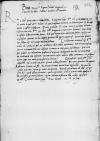⌊Bona⌋ Dei gratia regina ⌊Poloniae⌋, magna dux ⌊Lituaniae⌋, ⌊Russiae⌋, ⌊Prussiae⌋, ⌊Masoviae⌋ etc. domina
Accepimus litteras Paternitatis Vestrae, quibus eorum, quae de morte ⌊regiae maiestatis Poloniae⌋ ad eam scripsimus, meminit, et dolorem suum ex hac ipsa morte acceptum testificatur. Facile credimus Paternitatem Vestram vere et ex animo dolere, habuit enim Vestra Paternitas ex ⌊illius maiestate⌋ benignum et clementem dominum. Nos etiam in assiduo luctu et maerore sumus. Sed quae tamen Dei voluntate fiunt, in his nos acquiescere oportet et de omnibus gratias illi agere aequum est. Sicut Domino placuit, ita factum est. Sit nomen Domini benedictum.
Credebamus venturam esse Paternitatem Vestram ad sepulturam ⌊domini sui⌋, et libenter illam videre optabamus, tum ut nos reviseret, tum ut extremum domino suo defuncto honorem ac obsequium exhiberet. Sed cum per aetatem ac valetudinem praestare id nequeat, indulgemus hoc illi, ut commoditati ac valetudini suae inserviat. Verum tamen nostri non sit istic immemor et pristinam suam erga nos animi propensionem retineat.
Epitaphium, quod Paternitas Vestra defuncto ⌊regi⌋ ac domino suo fecit, placuit nobis plurimum. Pro quo gratias illi agimus.
Audimus venisse ad
illustrem dominum ⌊ducem Prussiae⌋ duces duos Germaniae, qui qua de causa venerint, latere Paternitatem Vestram non poterit. Proinde postulamus ab illa, ut qui sint hi, quid acturi venerint, quid confecerint, cito et exacte nobis significet, rem nobis gratam factura.
Quam salvam et felicem diu valere optamus.

